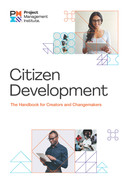| 4.2 Supporting Citizen Development |  |
This section provides the information you need to embed citizen development into the fabric of your organization.
The citizen development operating model is necessary to design, implement, and scale citizen development at an enterprise level.
In this section you will find:
•Information to help design and build a citizen development operating model that fits with organizations as they build capability and structures to support scaling of citizen development
•Details on roles, different types of citizen development operating models, and how these should align with the maturity of citizen development in the organization

“Change before you have to.”
Jack Welch
![]()
Overview
Putting in place an effective citizen development operating model is crucial to enabling the full potential of citizen development. It is ultimately a balancing act. If you set up specific structures, processes, and management practices underpinned by dedicated technology before citizen development has really taken root and started to grow, you will end up with confused accountabilities and unnecessary cost. Conversely, if the operating model required to support this growth is not implemented as the demand for citizen development grows, key elements of the operating model will be missing and you will risk stifling citizen development growth, or worse, stagnating it altogether.
This section explains the key elements of the citizen development operating model and how to design one that aligns with the organization and the maturity of citizen development within it. Being able to unlock the full potential of citizen development is dependent upon putting an effective operating model into place.
Citizen Development Operating Model Components
An effectively designed operating model is essential to successfully executing a strategy. It is defined as the culture, organizational structure, governance, capabilities, tools, technology, operating principles, metrics, and supporting documents that are required to execute an organization's strategy (Table 12). Culture is not covered in this section; however, it will be discussed in Section 5.2.
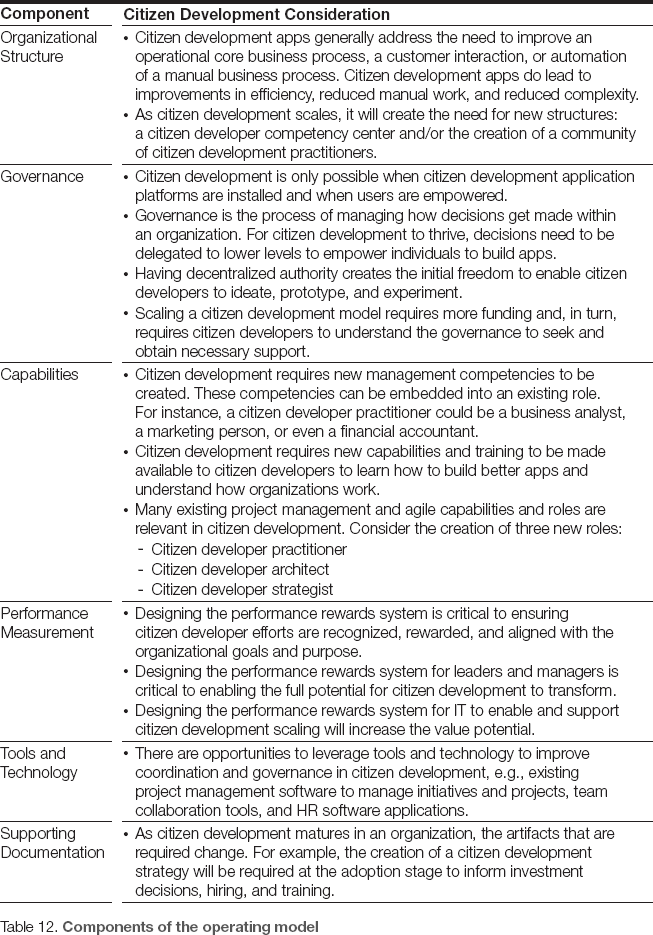
As organizations increase their capability in citizen development, they have a number of choices to make in terms of their citizen development operating model. These choices are influenced by the existing operating model and additional requirements that relate to the industry that the organization operates in.
Organizations will need to create new structures to handle the increasing demand for citizen development projects. There are three possible citizen development operating model options:
1.Citizen development competency center
2.Citizen development community of practice
3.Citizen development hybrid structure, combining both structures
It is important to recognize the current structure and its future intention before deciding on the appropriate structure.
Citizen development competency center
Competency centers tend to exist more in traditional hierarchical organizational settings that have grown over time through functional specialisms. Here, a natural extension is to create a functional specialism for citizen development or a competency center, also known as a center of excellence. The citizen development competency center can either be under the control of IT or sit within an operational support function. The competency center is set up to provide governance and the capability to control and enable citizen development to flourish. Hierarchical organizations are associated with a command and control management style where decisions are made top-down and authority and work are allocated and managed through communicating up and down the line management process.
Setting up a citizen development competency center has risk. When too many controls are put into place, the business community will see the center as a compliance function and will aim to avoid collaboration and engagement, undermining the success of citizen development within the organization. If you allow too much freedom, citizen development could bring all of the risks associated with scaling shadow IT, such as security breaches, hacking, theft, loss of data, fraud, and operational inefficiencies. The key is to get the balance right.
In organizations that have strong hierarchical controls in place, working cross-functionally tends to have friction that impacts the collaboration within the organization. These are seen as favors (requests without authority), and no recognition is given to those who give up their team to work with colleagues across organizational boundaries. In some situations, supporting a colleague causes down-side risks. The individual who assists a colleague can inadvertently be punished as it can result in longer, unrecognized hours and the potential to damage personal performance that is aligned with the objectives set by a line manager. Scaling citizen development organically is unlikely to be successful.
To scale citizen development, strategy and goal setting has to occur as a top-down initiative. Aligning objectives across organizational boundaries occurs through planning and principles that cascade down the organizational hierarchy. Here, corporate policies, rewards and recognition systems, and centrally allocated budget and resources are key to unlocking citizen development at scale. Formalized ways of working between IT and the business, with governance structures and formal terms of reference, bring clarity and direction and are necessary to bring accountability to enable citizen development. Table 13 describes how to implement a competency center in a hierarchical organization.
An effective competency center should provide a bridge between the business users and IT and can reside within the business or IT. It has three main functions:
•Oversee the governance processes (IT and business) within citizen development initiatives.
•Support citizen developers in building applications using the no-code or low-code platforms used in the organization, and provide both technical and citizen development practitioner training.
•Promote the scaling of citizen development across the organization, e.g., organizing events such as hackathons, evangelizing citizen development, and celebrating successes. This also includes support for hiring and training citizen developers and citizen development business case and funding activities.
Ultimately, the competency center's function is to support the business and encourage them to own, manage, and nurture their citizen development capability. The competency center must try to avoid the risk of it becoming a compliance or expert function.
The competency center should comprise an experienced team that has managed and built citizen development applications. The team should have hands-on experience, a knowledge of the processes in place to facilitate citizen development, and a deep understanding of the citizen development operating model within the organization. They should bring the technical knowledge and experience of the citizen development application platforms, experience of managing citizen development initiatives, good communication and interpersonal skills, and a commitment to scale citizen development within the organization.
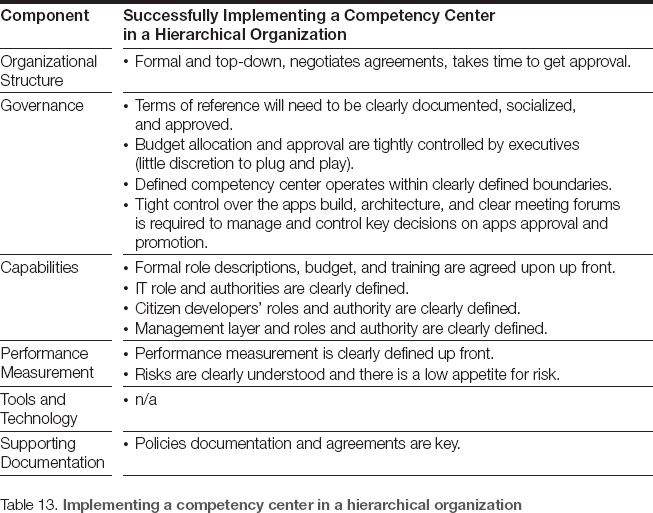
Where an organization is operating in a traditional way and wishes to move to a more agile or adaptive structure, then a hybrid structure can work well. Hybrid structures are discussed later on in this section.
Citizen development community of practice operating model
The citizen development community of practice is an alternative to a central competency center. It comprises a virtual team that reports into their existing functional or divisional areas. For instance, if a citizen developer works in finance and is a representative of the community, they continue to report into finance.
The community's goals are not dissimilar to those of the more formalized competency center. However, one key difference is that it can be seen as a less rigid, grassroots establishment, based on volunteers offering their time. This can serve to increase buy-in from peers in the organization. The downside is that it can be harder to sanction time for the community members unless the community of practice is formalized, e.g., by aligning citizen development work to the individual and functional objectives and those of their line managers.
For citizen development to scale, it is essential that the time the community spends on establishing, supporting, and scaling citizen development within the organization is formally endorsed. Another challenge with this operating model is that it is harder to scale and mobilize strategic initiatives, which can dilute the potential value to integrate citizen development as a strategic goal within an organization. These challenges are no different to challenges that leaders face when operating a devolved accountability structure.
A citizen development community of practice is well suited to organizations that operate in fast-moving industries with lower regulation requirements. This structure will thrive in entrepreneurial and innovative cultures where individuals and teams are encouraged to take risks and are given more decision-making authority. Table 14 describes how to implement a citizen development community of practice within an organization.
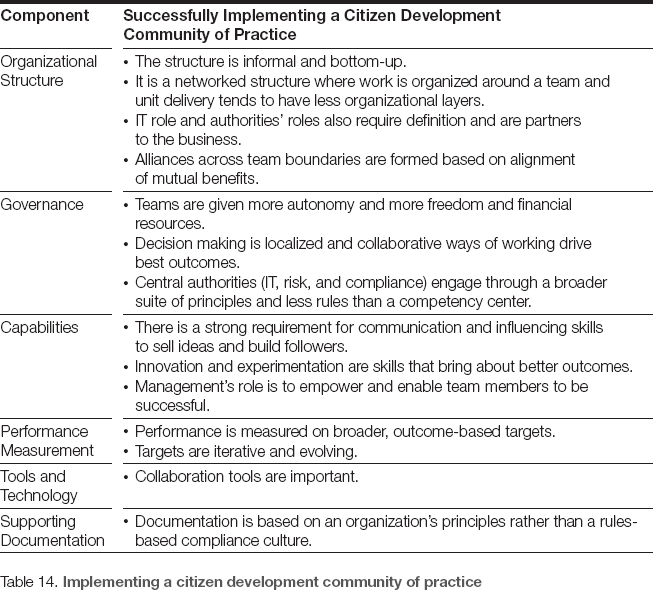
Citizen development hybrid operating model
The hybrid structure combines elements of both the competency center and the establishment of a community of practice and aims to address the benefits of both structures. For example, competency centers bring more structure and are easier to manage and scale than communities of practice, simply because they can achieve organizational alignment quickly through putting in place commitment and top-down direction. Conversely, achieving alignment and driving shared organizational outcomes from a community of practice is difficult and makes it challenging to embed citizen development application platforms as a strategic enterprise application. Depending upon the organization's approach (e.g., from a command-and-control or more devolved, network organizational structure), putting a hybrid operating model in place can work. If approaching it from a networked perspective, putting in place some more controls and giving more authority to a central competency center will bring alignment, structure, and better control. Approaching it from the other direction (e.g., if the organizational culture is formal and top-down), creating a community of practice with a light competency center will foster innovation and promote more buy-in from wider areas within the organization.
Many organizations are grappling with the intention to foster innovation and empower their workforce. For those organizations, we recommend a hybrid structure. It is important to clearly demarcate the boundaries of each structure: How does the competency center interact with the community? What are their specific remits and how do they work together to nurture and grow effective citizen development?
In all cases, the competency center and the community of practice will need a platform through which they can interact with and engage the organization. This can be anything from a simple forum where Q&As and FAQs can be shared or linked to, or it can be a much more feature-rich environment offering live chat, social feeds with dynamic content, access to templates and artifacts, training materials, courses, access to support, events, and so on.
Capabilities: Key roles and responsibilities
The roles outlined in this section can form part of an existing role. For instance, an agile coach could also be the architect, or the transformation director could also have responsibilities for the strategist or community architect. They can also be roles that are found within the competency center or may be spread throughout the organization. Regardless of where they sit, the following are the key roles involved in citizen development within an organization.
Sponsor: The sponsor is the person who is accountable for the project outcomes, obtains funding, manages internal buy-in, and ensures the project delivers the agreed benefits.
A citizen developer sponsor is typically someone with relative seniority in the organization. They can be a business executive who has declared they are accountable for citizen development, or someone in IT who wants to chart a different course to driving value quickly. It's a pivotal role in initiating a citizen development operating model. Without a sponsor, citizen development will fail. The sponsor could be at a local initiative level, say, a line manager who supports the squad, or they could be a forward-thinking executive board member. They understand the value citizen development can bring to the organizational strategy level.
At the discovery stage, citizen development is unlikely to take root in the organization. Sponsors lend credibility to the effort, are able to connect individuals who can support efforts in the early stages, and provide steering to ensure any citizen developer proving projects remains on track. They sanction the time and budget associated with these early citizen development activities and are the point of escalation for any roadblocks or challenges.
It is under the stewardship of the sponsor that the citizen development work can continue while it is effectively still unsanctioned. The sponsor will have sufficient seniority and budget control to be able to isolate activities from the standard governance and project procedures within the organization. They will have the authority and relationships to fend off, at least temporarily, any intrusive curiosity from stakeholders who eventually will need to be brought into the process.
Beyond the first stage of maturity, the sponsor continues to play a pivotal role. The sponsor is the most senior stakeholder close to the nascent citizen development activities and will be the one to eventually bring it out of the shadows. As such, the sponsor will need to be able to present the best possible case for citizen development, based on the relatively covert activities to date, and seek broader recognition and endorsement for citizen development. The sponsor's ultimate aim is to get the C-suite green light to establish and scale citizen development in the organization.
Squad: The squad is a small team of citizen developers focused on the delivery of a citizen development project. Squads can be agile teams and also have roles more aligned with agile, e.g., product manager or scrum master.
At the discovery stage, the squad is likely self-assembled or handpicked by a sponsor. At the adoption stage and beyond, the squad composition will be determined as part of the SDLC. Simple projects may be delivered by an individual, and complex projects require a scaling level of involvement from one or more dedicated specialists.
In order to be effective, the squad must comprise a number of important prerequisite capabilities and experiences. It is important to note that, in some cases, this can be a single person, but in most cases a small squad will need to be assembled.
•Project management: Hands-on past experience with managing projects or directly supporting their delivery, perhaps as a business analyst, solution architect, or technical subject matter expert
•Application development: An awareness of how a developer would go about creating an application (A general understanding of the IT landscape within the business and high-level architectural knowledge would be a benefit. A knowledge of coding or deeper architectural considerations, while useful, is not necessary.)
•Process analysis: An awareness of how to interpret, document, augment, and communicate organizational processes; an ability to facilitate process design sessions
•Business expertise: A solid understanding of the problem and how the solution will add value to the organization
•Stakeholder engagement: A process whereby all parties are adequately and appropriately involved in the decision-making process to achieve a desired common outcome (Scaling citizen development will require concerted efforts around stakeholder engagement. The ability to create, maintain, and execute a stakeholder engagement plan is a must.)
Practitioner: A citizen development practitioner is a trained and certified creator. Citizen development practitioners are experienced and qualified citizen developers who understand both how to use the citizen development platform in the organization and how to build compliant, scalable, and fit-for-purpose applications.
Practitioners are trained to either create applications themselves or support their colleagues through the citizen development SDLC to deliver scalable applications that are designed with the needs of the user and the business in mind. Practitioners can be said to be at least “minimally competent” in application development and user experience best practices, understand nonfunctional and architectural constraints, and have an appreciation for the importance of governance and IT procedures. Practitioners can sit within the dedicated citizen development competency center, within the business, or within IT. When part of IT or the competency center, their responsibility might extend to identifying training needs within the organization.
Architect: The citizen development architect is a trained and certified changemaker. Citizen development architects are experienced in the design and implementation of citizen development operating model best practices. They put in place the governance framework to ensure effective collaboration between IT and the business.
Architects work with all parts of the business to define the rules, standards, and procedures that ensure organizational alignment. Their involvement ensures that only safe, scalable, and compliant applications are being built. They can come from IT and may already be enterprise architects or come from the business as agile coaches, product owners, or line managers. Depending on their background, they may already have a proven knowledge of enterprise architectural methods and practices.
Their role is to create and facilitate access to the tools and methods that enable squads to build solutions that establish and enforce the boundaries within which citizen development can take place in the organization (the IT rules of engagement), and manage the organizational politics that give citizen developers the space to innovate and create solutions.
Architects play an important role in establishing, supporting, and executing the governance processes citizen development initiatives must follow.
Strategist: A citizen development strategist is a certified and experienced member of the senior management team who is trained to implement organization-wide citizen development strategies.
Citizen development strategists work closely with executives to create an operating environment that allows citizen development to thrive. Citizen development strategists are vital in an organization that has successfully moved into the experimentation stage of citizen development maturity. Their role comes into play once the C-level has formally endorsed citizen development. They leverage this endorsement to instill the cultural practices and mandates that foster deeper engagement and adoption of citizen development. They work closely with leaders to understand and design the organization in a way that not only recognizes citizen development efforts but also rewards them. They put into place the measuring and tracking mechanisms that, when supported by the practitioners and architects, enable the executives to gain visibility into the value being generated across the organization and, thereby, enable them to make informed decisions on budget allocation.
Community manager: This role may be played by the citizen development architect in the early days of citizen development adoption in an organization. As the scale of citizen development applications grows, the workload required may necessitate the creation of the separate role of a community manager.
Citizen development community managers are local evangelists for citizen development. They are trained in the basics of citizen development, are highly influential and networked, and know how to navigate organizational politics to get things done.
This role is at the heart of the citizen developer movement in an organization. Citizen development is as much about hearts and minds as it is about the technology and governance. It is the role of the community manager to facilitate deep, constant engagement with the wider community. Depending on the maturity of citizen development in the organization, community managers may have dedicated tools or platforms that enable them to fulfill this role; however, regardless of the medium, community managers are responsible for creating and sustaining the hype around citizen development.
They will need to work closely with citizen developer squads in order to capture use cases, success stories, and “a day in the life of…” interviews. They will be responsible for facilitating the discussion forums that allow developers to interact and engage with their community of users or other interested parties. They will want to put in place feedback loops that allow squads to seek out and involve the business in the codevelopment of applications. They should set up and encourage the wider community to host informal meetups, brown-bag lunches, or show and tells on the business premises or via online streams. They will want to arrange high-impact, high-visibility events, such as hackathons, engaging external thought leaders and speakers to attend. They must continue to facilitate the capture and communication of external use cases that serve to inspire the community.
| DEFINITION |
User story
In software and systems engineering, a list of actions or event steps typically defining the interactions between a role and a system to achieve a goal; the actor can be a human or other external system (“User Story,” 2020).
Community managers do not work in isolation. In the early stages of maturity, community management is a targeted affair with the focus on highly tailored communications with a predetermined audience. It is only once the organization moves into the experimentation stage of maturity and beyond that this role becomes formalized in its own right. The community manager may sit within the competency center or within the business where they already have a related role, possibly within marketing or communications.
Other roles: There are many other roles that make up the composition of a citizen development operating model, from the governance of the CIO and business leaders to the guidance required from technical architects. In this section, however, we described key roles that are important to support and enable citizen development and are required within all citizen development operating models.
Citizen development operating model and the maturity model
The first step toward determining an organization's operating model is to diagnose where on the citizen development maturity scale the organization currently is. We show this relationship in Figure 16.
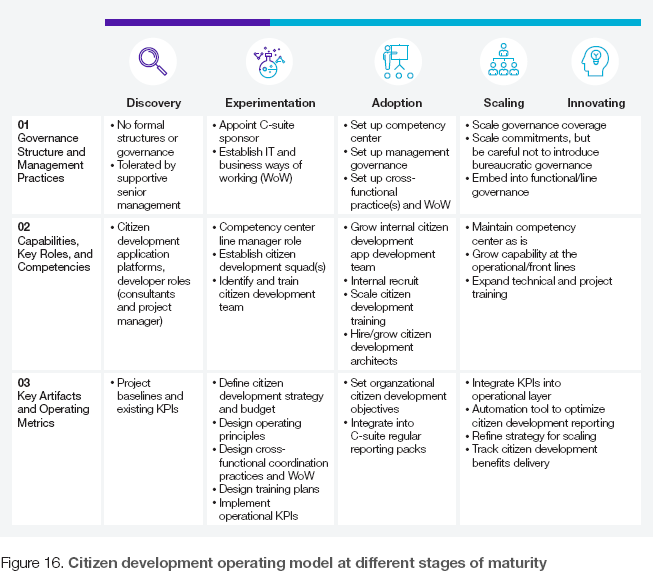
Governance structure and management practices: To get started, very little governance is required because experimentation is key. Getting C-suite sponsorship is required at the experimentation stage to ensure appropriate attention is given to prioritize and align citizen development projects with the various related initiatives within the organization. At the experimentation stage, it is necessary to estimate governance and ways of working between IT and the business. The next major development occurs at the adoption stage, which involves setting up the competency center and embedding citizen development objectives across the organization by leveraging existing meeting practices. It may be necessary to establish a new meeting forum(s) to enable cross-functional cooperation on citizen development initiatives that stretch across the functional boundaries.
Capabilities: At the early stages of maturity, citizen development capabilities will be mixed, and the level of competencies to develop robust applications will be variable and reliant on the individual's skills and competency. This creates potential risk, which can be managed by limiting the citizen development application to areas of lower risk. Upon delivery of the first few use cases, start to design the competency center and develop the roles and staff for inclusion. Build architect skills. The size of the team will depend on your ambition to scale citizen development within the organization.
Artifacts and operating metrics: The level of documentation and measurement requirements grows as citizen development matures in the organization. Initially, when introduced, project management metrics can be borrowed directly from standard project measurement practices. As the use of citizen development grows, it requires more formalized systems of measurement, which are covered in the KPIs and value tree sections of the book.
| LEARN MORE |
To learn more about strategy, please visit:
https://www.PMI.org/learning/featured-topics/strategy
To learn more about competency centers, please visit:
https://www.ibm.com/garage/method/practices/culture/practice_center_of_competency/
To learn more about proving projects, please visit:
https://www.PMI.org/learning/library/strategy-projects-proving-value-2844
To learn more about scrum master roles, please visit:
https://www.cio.com/article/3223139/what-is-a-scrum-master-a-key-role-for-project-success.html
